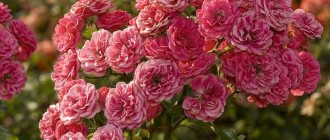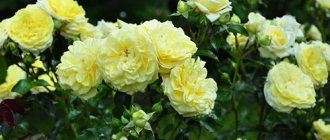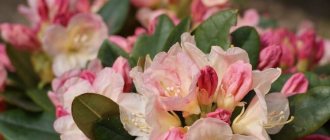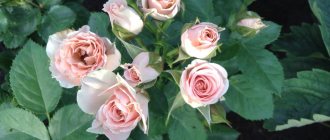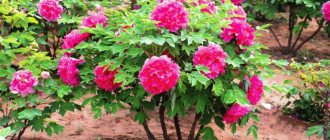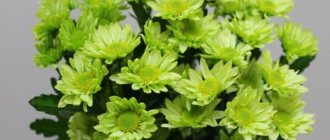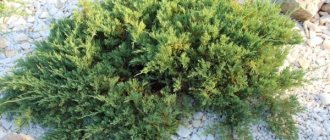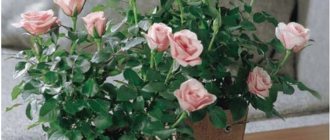Climbing roses have long won the hearts of both experienced and novice gardeners. These plants are a spectacular and chic decoration for any garden. Climbing roses look no less organically in vertical gardening elements and flower arches. Modern selection has solved many problems for rose gardens: the abundance of varieties will satisfy the most demanding connoisseurs of beauty, and it is possible to cultivate roses in any climate zone, even with low winter temperatures and harsh winds. We talk about which variety of climbing roses to choose among their diversity in our article.
Features of climbing roses
East Asia is considered the birthplace of all modern varieties and varieties of climbing roses. It was there, on the territory of ancient China, Japan, and Taiwan, that wild climbing roses grew, which over time began to be cultivated and distributed throughout the world. The main difference between climbing roses is their type of growth. Thanks to their long, curly shoots, they spread along the ground, and if they are tied up, they entwine various structures.
The shoots of these roses are quite flexible, so if desired, this rose can be given a certain shape
The shoots of these roses are quite flexible, so this rose can be given a certain shape if desired. To do this, a support of a certain type is made and as the bush grows, its pagons are directed to this support so that it gradually becomes entwined. The maximum length of shoots of climbing roses is 17 m, but this is very rare. Usually the length of the lashes is only a few meters, but this is more than enough to create a beautiful composition.
Interesting!
In ancient East Asian countries, all climbing roses were called Vihura.
Planting and propagation
Climbing roses are planted from mid-April to the end of May or already in the fall, at the end of September. It is most convenient to plant seedlings. First, immerse them in water for a day, then cut off all the leaves with immature and damaged shoots. Trim the root and ground parts so that approximately 30 cm remain.
Treat all cuts with sharpened charcoal, and when working with grafted seedlings, remove everything almost to the graft site. Disinfect the roses in copper sulfate and plant them in 50x50 cm holes at intervals of 1 m. Mix the top layer of soil with organic fertilizers and partially pour it onto the bottom of the hole, and partially spread it on top.
When planting, carefully straighten all the roots so that they do not bend. Cover the hole with soil mixture, compact it and fill it with soil. When the soil settles a little after watering, add more soil and manure mixture. When planting grafted seedlings, the grafting site should be underground at a depth of 10 cm. After this, the rose is hilled up to 20 cm.
In the spring, the planting technique remains the same, but the ground part needs to be shortened to 15-20 cm. In addition, in the spring, climbing roses are covered with film and ventilated for several minutes every day. The film is removed when the risk of night frosts has completely passed.
Photo: aprillesgarden.blogspot.com
Predecessors of climbing roses
The origin of climbing varieties is associated with two wild species - Multiflora and Rosehip Vikhura.
Multiflora
Rosehip multiflora or multiflora is native to Japan, Korea, and the island of Taiwan. It has long flexible shoots up to 3 meters long and numerous white or pink flowers about 2 cm in diameter with a faint cinnamon scent. Once in Europe, this rose hip was enthusiastically received, and is still found in parks and large areas. It is often used to create hedges. It is distinguished by lush, abundant flowering throughout the month.
Rosehip Vikhura
This rose hip came to Europe from China, Korea, Japan, and the Philippines. In its homeland it forms picturesque bush thickets. The outstretched bushes can reach almost two meters in height, but almost 6 meters in width. They are distinguished by white or pink fragrant flowers that are quite large for a rosehip - 1.5-3.0 cm in diameter.
A little about the classification of roses
Roses are loved by amateur gardeners, landscape designers and residents of megacities, who enjoy admiring them in city parks, on TV or computer screens, in lush fragrant bouquets. Breeders from all countries love these flowers. Through their efforts, so many varieties have been created that it is impossible to count - from 25 to 50 thousand.
The garden classification of roses has already been discussed in one of our previous articles.
It is constantly changing, since it is not based on the species affiliation of this or that variety - this is simply impossible due to centuries-old selection, repeated inter- and intraspecific crossing. Most roses today simply cannot be traced back to their wild ancestor - one of the 400 species of wild rose hips.
Therefore, stable garden characteristics - biological and decorative characteristics of varieties - were taken as the basis for the classification of roses. Nowadays it is customary to divide roses according to their use in design. The classification constantly undergoes minor changes with the advent of new varieties - breeders do not adhere to boundaries, they simply create a beautiful flower and do not care that it does not fall into any of the groups.
On a global scale, all roses are divided into three huge sectors:
- Species Roses – wild (botanical) species;
- Old Garden Roses are old garden roses from before 1867, preserved without modification. This year is remarkable because the first hybrid tea rose “La France” appeared, which marked the beginning of the history of modern roses. The varieties of the old selection are much inferior in variety and decorativeness to modern roses, but they are all beautiful and deserve special treatment.
- Modern Roses are modern garden roses that appeared after 1867.
As you can see, when we talk about roses by modern varieties, we mean even those that appeared a century and a half ago.
Frost-resistant rose varieties for the Urals
The difficulties of growing roses in unfavorable climatic conditions are still relevant today. Breeders have developed unpretentious and winter-hardy varieties that will feel good and bloom profusely in the Urals.
John Cabot
The rose bush has flexible shoots. Blooms twice per season with bright pink glossy flowers. The John Cabot variety is quite unpretentious and winter-hardy.
Henry Kelsey
It is considered the best variety for the Ural region, as it is unpretentious and winter-hardy. Red, almost scarlet inflorescences emit a delicate, fragrant aroma. The plant blooms very profusely, twice per season.
Rosarium Western
The variety is characterized by powerful long shoots reaching three meters. The flowers are large, up to 12 cm in diameter, rich pink in color. Well preserved when cut. The plant is unpretentious and resistant to many types of diseases.
Golden Celebration
The variety of English selection is characterized by increased winter hardiness. Flowers of bright yellow shades abundantly cover the shoots of the bush and emit caramel and wine notes of aroma.
It is recommended to give preference to varieties bred directly in the Urals region, which have been tested by frost and temperature fluctuations. Particular unpretentiousness and cold resistance are characteristic of roses of the Canadian line.
Unpretentious winter-hardy varieties for growing in the Moscow region
Roses grown in the Moscow region must be resistant to temperature changes. There are varieties that bloom well in unstable climates.
Amadeus
A climbing rose blooming with rich red flowers. The inflorescences are united in brushes, creating splendor. The plant is tall and spreading, which allows you to decorate large surfaces. It blooms in the Moscow region from early spring to late autumn.
Gloria Day
The classic, popular variety of hybrid tea roses has exquisitely beautiful buds with a light, delicate aroma. The color of double flowers is pink, turning into yellow tones. The petals have a bright crimson border.
Jubilee of the Prince of Monaco
The Floribunda rose variety is strewn with delicate flowers. The buds have a milky color, which changes during the blooming process and reaches a rich red hue. The color duality and abundance of buds makes the plant especially decorative.
Super Dorothy
Ground cover variety, German selection. In the conditions of the Moscow region it blooms very profusely and twice a season. Delicate pink buds cover the shoots almost completely.
Pierre de Ronsard
The climbing rose of French selection is distinguished by the absence of thorns. The plant blooms with creamy, goblet-shaped flowers. This variety is used to decorate arches, fences, and gazebos.
INTERESTING. A rose flower produces a fruit - a rose hip. It can decorate a bush in the fall and be food for birds.
How to care for winter-hardy rose varieties
There are a number of rules for growing winter-hardy rose bushes. Their implementation will allow even a novice florist to admire the magnificent bloom of the queen of flowers.
- The landing site should be well lit and slightly elevated. Direct sunlight at midday and drafts are undesirable.
- Soil that is rich in organic matter, light, and well-permeable to air and water is considered favorable.
- The planting hole must be voluminous. At least 0.6 m deep.
- The soil mixture should contain compost, fertile soil, and sand in equal quantities.
- It is necessary to add wood ash and potassium - phosphate fertilizers.
- Bush plants are planted at a distance of 0.8 - 1.0 m from each other. Climbing varieties up to 1.5 m.
- After planting, it is recommended to sprinkle the ground with straw or sawdust mulch.
- A solution of potassium nitrate is added during budding. Calculate 3 tsp. for 10 liters of water.
- In early spring, rotted manure or other nitrogen fertilizer is applied under the bush.
- In autumn, complex fertilizers are required.
- Watering is regular and plentiful.
- Pruning is carried out in the fall. Diseased shoots, faded flowers and stems growing inside the bush are cut out.
- Before winter, the ground under the bushes can be covered with a thick layer of mulch. Cover the bushes with breathable material.
ON A NOTE. When planting a rose for the first time, you need to have courage and patience. And she will thank you with beautiful flowers.
Answers to frequently asked questions
Most often, gardeners have the following questions:
How to preserve a seedling with an open root system until planting time?
You can temporarily plant the rose in a container and keep it at home until planting.
Is drip irrigation suitable for roses?
Can be used if irrigation ensures deep penetration of water.
When do you need to cover roses for the winter?
Roses easily tolerate light frosts; it is more dangerous for them to remain under cover. It is recommended to cover the bushes at a stable temperature of -100C.
Where is the best place to buy seedlings?
In order not to buy a “pig in a poke,” it is advisable to purchase seedlings in specialized nurseries or large garden stores.
Common mistakes
The opinion that the rose is a whimsical, difficult to grow flower is unfounded. This is the impression that novice gardeners may get when they make typical mistakes when growing queen flowers.
Incorrect planting conditions
- Planting the plant in a location with direct midday sunlight.
- Proximity of groundwater.
- Insufficient graft depth.
Conditions of care
- Incorrect watering schedule.
- Overdrying or waterlogging of the root ball of the earth.
- Insufficient pruning.
- Deficiency in fertilizer application.
- Sheltering for the winter ahead of schedule.
Almost all mistakes when growing roses can be corrected. A flower, transplanted to a comfortable place, provided with proper watering and fertilizing, will quickly grow and begin to bloom.
Formation of climbing roses
Another article will tell you in detail about the formation of climbing and climbing roses. We note that climbing varieties definitely need support, since their selection was carried out in such a way that their shoots were as long as possible, flexible and easy to tie up. Only some varieties have powerful, not too long shoots. They were not classified into another group only because they bloom, like all climbing roses, on last year’s branches.
Most often, climbing varieties are grown in the form of a fan - the main and skeletal shoots are placed horizontally or in a fan. They are tied to a strong support, braided in plastic with wire.
Important! Do not fasten the wire too tightly - when the stem becomes thicker, it may simply crush it.
Thin vertical branches will grow from horizontally located thick shoots, on which flowering will occur.
Attention! Young shoots should be protected under no circumstances by pruning them for the winter, even if they are not fully ripe (cover them better) - it is on them that flowering will occur in the next season.
It is climbing roses that are planted next to the arches. Watch a video about planting options for climbing varieties:
It is important to remember that you need to form climbing varieties right away - they grow very quickly, if you miss at least a year, it will be very difficult to put the shoots in order.
Winter-hardy rose varieties for Siberia
The successes of modern selection have made it possible to grow magnificent flowers in the North. Frost-resistant varieties, resistant to temperature changes and diseases. There are many varieties of roses adapted to the conditions of Siberia; let’s consider the most winter-hardy and hardy of them.
Queen Elizabeth
The tall bush plant is very compact and does not require much space. The rose blooms with double, goblet-shaped flowers of a delicate pink color. The variety is unpretentious to soil quality and tolerates strong temperature changes.
Golden Celebration
A bush rose with a round, even crown can be used for mixborders. The plant blooms with flowers with a copper tint. Inflorescences of the classic type, large, up to 15 cm in diameter. The aroma is fruity with notes of spice.
William Shakespeare 2000
The rich, lush bush blooms with scarlet flowers. Young shoots quickly enter the flowering process, forming large clusters. Dense flowers up to 10 cm in diameter stay on the bush for a long time and emit a characteristic pink aroma.
Westerland
The wide and tall bush blooms with large double flowers that change color. During the flowering period, the flowers change tone from orange and peach shades to pink, which gives the plant a special decorative appearance. Used for single plantings.
New Dawn
The climbing type rose grows up to 5 meters on a support. The variety is characterized by continuous, long flowering. Buds and small flowers of delicate pink pastel colors are densely located on the shoots.
ON A NOTE. Knowledge of the characteristics of varieties, the peculiarities of agricultural technology, the rules of planting and covering with the factor of a correctly selected variety guarantees the result in the form of a beautiful, flowering plant.
Popular varieties
- Ave Maria grows medium-sized flowers with a strong aroma. The shoots are located on a climbing bush, which blooms quite profusely and intermittently. The cost ranges from 300 to 500 rubles.
- Aelita is famous for its large flowers, the diameter of which reaches 8–10 cm. The petals feel terry to the touch and are white. The cost is no more than 500 rubles.
- Berlin differs from all other varieties in its buds, which grow in an elongated, pointed shape. The flowers have a weak, modest, fragrant aroma. Leathery leaves of dark green color. The cost is 350 – 390 rubles.
- Hamburg grows with pointed buds. The petals are a delicate crimson color and quite large. The aroma is faint. The cost of this variety reaches 500 rubles or more.
- Mermaid has large flowers, the diameter of which reaches up to 9 cm. The petals are open, yellowish in color. The aroma is very pleasant and fragrant. The cost does not exceed 500 rubles.
- Pake is famous for its pure white petals. It blooms throughout the summer in a very intensive mode. The cost of this variety starts from 500 rubles or more.
Ave Maria
Aelita
Berlin
Hamburg
Mermaid
Pake
Tips for gardeners on choosing a variety
- In fact, every gardener chooses a variety based on his wishes and goals. If the goal is to create a decorative look at the dacha or near the house, then climbing rambler roses can be an excellent solution.
- It is best to choose several different types of Rambler roses. All species bloom in their own way and with their own characteristics. The most important thing is that each species grows at different times of summer and for different periods of time. By combining several types of Rambler roses you can get an excellent composition that will delight you with its floral mix.
- This “mixture” can be placed near the gate of the house or , conversely, you can make an arch of roses.
- Someone will prefer roses of the Climing variety. The choice is up to every gardener. Each variety and species is beautiful in its own way and has its own advantages, such as, for example, resistance to frost, diseases and harmful insects.
Ground cover unpretentious winter-hardy roses
All varieties of ground cover roses are characterized by a long flowering period and high resistance to most diseases. They are easy to care for. No special knowledge is required when growing these roses. Also considered winter-hardy.
Swani
French variety. The plant is unpretentious, blooms with double bright white flowers collected in large clusters. Characterized by abundant flowering, the flowers densely cover the entire surface of the shoots, creating a white carpet.
Purple Hayes
A variety of German selection. The flowers are simple, not double, deep red and provide decorative value in their quantity. The flowers emit virtually no fragrance. The plant is winter-hardy and unpretentious.
Bonica
This rose is most often used for group plantings. The flowers are pale pink and have delicate wavy petals. The variety is resistant to rain and unpretentious in terms of care. Winter-hardy.
Eskimo
An upright bush of graceful shape. Characterized by long-term flowering with small white flowers of a simple type. It is highly resistant to diseases. Unpretentious and winter-hardy. Widely used in landscape design.
An unpretentious, small shrub with an erect bush of a beautiful graceful shape. The foliage is very disease resistant and blooms all summer with white, single, weather-resistant flowers. Looks great in the landscape.
IMPORTANT . Low-growing bushes of ground cover roses are indispensable when decorating garden space, borders, and decorating living spaces when grown in pots and flowerpots.
The best winter-hardy roses for Central Russia
Before purchasing planting material, gardeners in Central Russia are advised to familiarize themselves with unpretentious and winter-hardy varieties of roses.
When choosing, you need to pay attention to whether they are resistant to temperature changes, winter-hardy, unpretentious and resistant to rain.
The following are considered the best varieties for Central Russia.
Hommage a Barbara
Tea rose blooms with large double flowers of rich red color. The surface of the petals is velvety with a slight black coating.
Unopened buds are almost black. The plant is highly resistant to rain. The variety is of the self-cleaning type, which makes maintenance easier.
The rose blooms profusely, the inflorescences cover the entire bush. The foliage is decorative, glossy, and practically not affected by diseases and aphids.
Dieter Muller
The plant blooms with rich lilac and purple flowers of a classic look. A strong, spicy, refined aroma spreads from the buds.
Powerful bushes with a neat crown are strewn with lilac buds. As they bloom, they acquire an exquisite pink-lilac color. The rose is resistant to most diseases and cold.
Ascot
A plant with a compact, strong crown forms single buds and multi-flowered inflorescences on its shoots. Large flowers of the classic old type have a spherical peony shape.
The color of the petals plays. It can be called crimson, purple and even crimson with a violet tint. The variety is characterized by good frost resistance and high immunity to diseases.
Santana
The fast-growing plant belongs to the climbing roses. Can be grown on a support or as a scrub. The shoots are completely covered with semi-double flowers. The velvety, rich red buds are collected in clusters and reach a diameter of 10–12 cm.
The rose blooms once and pleases with its flowering for a long time, until autumn. The variety is not picky about the soil, is frost-resistant and does not require specialized care.
Lady of Shalott
Leader in frost resistance and disease resistance. The plant has a long flowering period. Pleases with orange, densely double flowers all season long. In addition to its chic appearance, the rose has a rich aroma with hints of tea and apple.
ON A NOTE. In Central Russia it is difficult to predict the weather. Cold rainy or hot dry summers, wet warm winters or bitter frosts. The results of modern selection have allowed rose lovers to grow them in unstable weather conditions, with large temperature changes.
For Siberia and the Urals
Swan Lake (Swan Lake)
An elegant and luxurious variety of climbing roses with milky-white large flowers with a diameter of 10-15 centimeters. Rose of Irish breeding, bred in 1968. The foliage is dark green, the bush is powerful. Tolerates even the most dramatic temperature changes and is resistant to freezing.
Rosarium Jutersen
For a description of this variety, see above in the group “The most beautiful, spectacular varieties of climbing roses.”
Sympathy
For a description of this variety, see above in the group “Varieties of climbing roses that bloom all summer.”
Bajazzo
German climbing climate-hardened rose. The flowers are bright red with a yellow center, semi-double, medium in size, reaching 7-9 cm in bloom. The height of the bush is about 2.5 meters. Resistant to diseases and harsh climatic conditions with temperature changes.
Perennial blue
An unusual variety of climbing roses with flowers of a unique lilac-pinkish hue - purple-magenta. Semi-double, they are collected in inflorescences of 7-10 flowers in a brush. They bloom spectacularly all season long in waves. The height of an adult plant is up to 3 meters.
Coral Sunset
A variety of double climbing roses with bright pink buds with a coral tint. Flowers are collected in brushes of 4-6 pieces. The height of the bush reaches a maximum of about 2 meters. Forms lateral shoots well. Resistant to weather changes and sudden temperature peaks.
Aloha
A climbing rose with magnificent double flowers of apricot color with a red edging along the outer edge of the corolla. The height of the bush is about 3 meters, flowering in several waves. Conditionally frost-resistant variety.
Endless pink
A climber variety with dark green velvety foliage and fragrant, double rich pink clusters of flowers. Blooms profusely all season. The diameter of the blooming buds is up to 7 centimeters.
Flamentanz
For a description of this variety, see above in the group “The most spectacular, beautiful varieties of climbing roses.”
Symbolic meaning of the flower
Flowers are a great way to say “thank you” or say you’re sorry, so choosing the right color is important because that’s the meaning of the gift. Since burgundy roses come in different shades, each of them has its own symbolic meaning:
- A burgundy rose, like a red one, is a true symbol of passion, warm feelings of the giver, an ideal gift for a friend or wife;
- A rose of deep burgundy color is a sign of respect, admiration for endless beauty, it is suitable for older women;
- The light color of flowers expresses charm and admiration for a person; such compositions are suitable for celebrating an anniversary;
- A darker, almost black color symbolizes closeness, deep respect, sometimes even regret - such flowers are often given as gifts in the business world.
When choosing roses for a lady, preference should be given to unopened, compact buds, since too open buds symbolize wilting.

